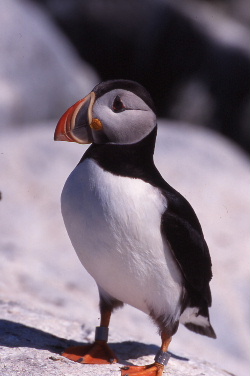Atlantic Puffins have once again arrived in Maine for the breeding season, and, unlike last year, are finding plenty of food for their chicks. Last year, there was a shortage of hake and herring that resulted in the deaths of many puffin chicks, but this year it seems like there is enough food. However, researchers are still concerned. The number of puffins on the islands of Maticinus Rock and Seal Island has decreased by a third, even though these two islands are closely monitored by the Fish and Wildlife Service and the Audubon Society.
Atlantic puffins are beautiful birds with a unique lifestyle. Their bills are brightly colored, with a mix of reddish stripes and yellow spots. They are a diving bird, and will dive down as far as 200 feet below the surface in search of food. Like penguins, they use their wings to “fly” under the water for 20-30 seconds and can carry several fish at a time due to the sharp, tooth-like structures on the roof of their mouths. These birds are becoming a major tourist attraction in the Gulf of Maine, but a hundred years ago the population was nearly wiped out as people hunted them for their eggs, meat, and feathers.
Research suggests that puffins are more sensitive to environmental changes than other seabirds because they are less able to adapt. While stopping their decline is difficult, this sensitivity can help scientists study the changes in ocean climate.
Learn more about this research here.

